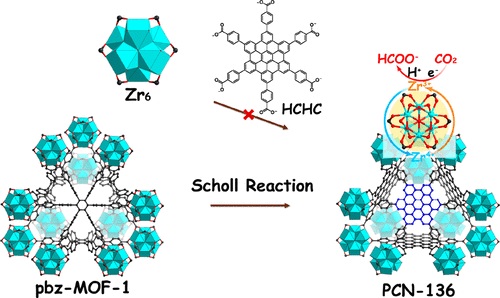兰亚乾教授课题组在JOURNAL OF THE AMERICAN CHEMICAL SOCIETY发表研究论文
Creating Well-Defined Hexabenzocoronene in Zirconium Metal-Organic Framework by Postsynthetic Annulation
Qin, JS (Qin, Jun-Sheng)[ 1,6 ] ; Yuan, S (Yuan, Shuai)[ 1,7 ] ; Zhang, L (Zhang, Lei)[ 3 ] ; Li, B (Li, Bao)[ 1 ] ; Du, DY (Du, Dong-Ying)[ 4,5 ] ; Huang, N (Huang, Ning)[ 1 ] ; Guan, W (Guan, Wei)[ 4,5 ] ; Drake, HF (Drake, Hannah F.)[ 1 ] ; Pang, JD (Pang, Jiandong)[ 1 ] ; Lan, YQ (Lan, Ya-Qian)[ 3 ]*(兰亚乾); Alsalme, A (Alsalme, Ali)[ 2 ]*; Zhou, HC (Zhou, Hong-Cai)[ 1,2 ]*
[ 1 ] Texas A&M Univ, Dept Chem, College Stn, TX 77843 USA
[ 2 ] King Saud Univ, Dept Chem, Coll Sci, Riyadh 11451, Saudi Arabia
[ 3 ] Nanjing Normal Univ, Sch Chem & Mat Sci, Nanjing 210023, Jiangsu, Peoples R China
[ 4 ] Northeast Normal Univ, Inst Funct Mat Chem, Dept Chem, Changchun 130024, Peoples R China
[ 5 ] Northeast Normal Univ, Natl & Local United Engn Lab Power Battery, Dept Chem, Changchun 130024, Peoples R China
[ 6 ] Jilin Univ, State Key Lab Inorgan Synth & Preparat Chem, Coll Chem, Int Ctr Future Sci, Changchun 130012, Jilin, Peoples R China
[ 7 ] MIT, Dept Mech Engn, Dept Mat Sci & Engn, Cambridge, MA 02139 USA
JOURNAL OF THE AMERICAN CHEMICAL SOCIETY,201902,141(5),2054-2060
The incorporation of large pi-conjugated ligands into metal-organic frameworks (MOFs) can introduce intriguing photophysical and electrochemical properties into the framework. However, these effects are often hindered by the strong pi-pi interaction and the low solubility of the arylated ligands. Herein, we report the synthesis of a porous zirconium-based MOF, Zr-6(mu(3)-O)(4)(mu(3)-OH)(4)(OH)(6)(H2O)(6)(HCHC) (PCN-136, HCHC = hexakis(4-carboxyphenyl)hexabenzocoronene), which is composed of a hexacarboxylate linker with a pi-conjugated hexabenzocoronene moiety. Direct assembly of the Zr4+ metal centers and the HCHC ligands was unsuccessful due to the low solubility and the unfavorable conformation of the arylated HCHC ligand. Therefore, PCN-136 was obtained from aromatization-driven postsynthetic annulation of the hexaphenylbenzene fragment in a preformed framework (pbz-MOF-1) to avoid pi-pi stacking. This postsynthetic modification was done through a single-crystal-to-single-crystal transformation and was clearly observable utilizing single-crystal X-ray crystallography. The formation of large pi-conjugated systems on the organic linker dramatically enhanced the photoresponsive properties of PCN-136. With isolated hexabenzocoronene moieties as photosensitizers and Zr-oxo clusters as catalytic sites, PCN-136 was employed as an inherent photocatalytic system for CO2 reduction under visible-light irradiation, which showed increased activity compared with pbz-MOF-1.

文章链接:
https://pubs.acs.org.ccindex.cn/doi/10.1021/j
acs.8b11042
版权与免责声明:本网页的内容由收集互联网上公开发布的信息整理获得。目的在于传递信息及分享,并不意味着赞同其观点或证实其真实性,也不构成其他建议。仅提供交流平台,不为其版权负责。如涉及侵权,请联系我们及时修改或删除。邮箱:sales@allpeptide.com